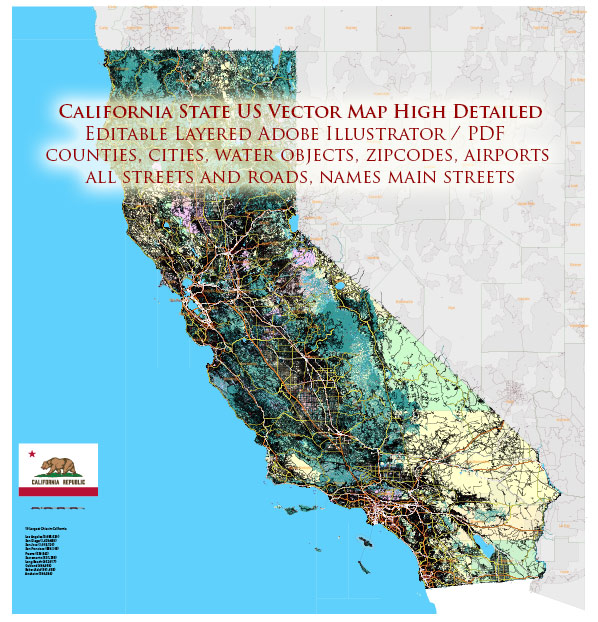California’s political and economic history is rich and complex, shaped by a variety of factors including Spanish colonization, the Gold Rush, agricultural development, technological innovation, and demographic changes.
Vectormap.Net provide you with the most accurate and up-to-date vector maps in Adobe Illustrator, PDF and other formats, designed for editing and printing. Please read the vector map descriptions carefully.
Here’s a detailed overview of the political and economic history of California:
Political History:
Spanish and Mexican Period (1769-1848):
- The Spanish explorer Gaspar de Portolà led an expedition to California in 1769, marking the beginning of Spanish colonization.
- The Spanish established missions, presidios, and pueblos to convert Native Americans to Christianity and establish control.
- Mexico gained independence from Spain in 1821, and California became a Mexican territory.
- Mexican rule was characterized by land grants to private individuals, including ranchos, and a relatively small non-indigenous population.
American Conquest and Statehood (1848-1850):
- The Mexican-American War (1846-1848) resulted in the Treaty of Guadalupe Hidalgo, ceding California to the United States in 1848.
- The discovery of gold at Sutter’s Mill in 1848 sparked the California Gold Rush, bringing a massive influx of people seeking fortune.
- California’s population exploded, leading to the need for organized governance. The region became a state on September 9, 1850.
Civil War and Postwar Era (1861-1900):
- California played a crucial role in the Union during the Civil War, supplying gold and troops.
- The completion of the First Transcontinental Railroad in 1869 connected California to the rest of the nation, boosting economic development.
- Agriculture, especially citrus and wine production, became significant during this period.
Early 20th Century (1900-1945):
- The film industry, centered in Hollywood, became a major economic and cultural force in the early 20th century.
- The Great Depression had a severe impact on the state’s economy, but recovery began with World War II, as California became a hub for defense industries.
Post-WWII and the Rise of the Suburbs (1945-1980):
- The postwar period saw tremendous population growth due to migration from other states and countries.
- The aerospace and technology industries, centered in Silicon Valley, began to flourish.
- The construction of highways and the rise of suburban living transformed the state’s landscape.
Late 20th Century and Beyond (1980-present):
- California faced economic challenges in the 1980s, including the collapse of the aerospace industry, but the rise of technology and the internet fueled a new era of prosperity.
- The state has become a global economic powerhouse, home to major tech companies, entertainment studios, and a diverse range of industries.
- Challenges persist, including issues of income inequality, housing affordability, and environmental concerns.
Economic History:
Gold Rush and Early Agriculture (1848-1900):
- The Gold Rush of 1849 brought a rapid influx of people, leading to the establishment of mining camps and towns.
- Agriculture, particularly wheat cultivation, played a crucial role in the state’s early economy.
Agricultural Boom and Industrialization (1900-1945):
- The expansion of irrigation systems transformed California into a major agricultural producer, specializing in crops like citrus fruits, grapes, and almonds.
- The film industry, centered in Hollywood, became a major economic driver.
Post-WWII Economic Transformation (1945-1980):
- The aerospace industry, fueled by the Cold War, became a cornerstone of the state’s economy.
- The technology sector, especially Silicon Valley, began to grow in importance.
- California’s population and economy boomed, driven by a combination of aerospace, technology, and suburban development.
Technology and Global Economic Powerhouse (1980-present):
- Silicon Valley emerged as a global center for technology and innovation.
- The entertainment industry continued to thrive, with Hollywood influencing global popular culture.
- The state became a leader in renewable energy and environmental initiatives.
Challenges and Opportunities:
- While California’s economy has thrived, it also faces challenges such as housing affordability, income inequality, and environmental concerns.
- The state continues to be a major player in global trade, technology, entertainment, and agriculture.
In summary, California’s political and economic history reflects a dynamic evolution from Spanish colonization to becoming a global economic powerhouse, shaped by factors such as gold, agriculture, aerospace, technology, and entertainment.


 Author: Kirill Shrayber, Ph.D.
Author: Kirill Shrayber, Ph.D.